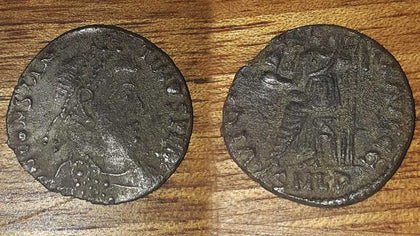Roman Siliqua Silver Coin Found with OKM's PI Detector

Detected with
OKM Pulse Nova
Depth: 0.2 m (0.7 ft)
Region: Rome
Time of origin: 400 AD
Size: 1.6 mm | 0.6" (D)
Weight: 1.55 g | 0.05 oz
Sometimes history rises to the surface in the most unexpected moments. During a routine search with the powerful OKM Pulse Nova, a team of treasure hunters uncovered a remarkable find just 7.8 inches, or 20 centimeters, below the ground. What emerged was not simply a coin, but a silent witness to a long forgotten chapter of the Roman Empire: a beautifully preserved Siliqua silver coin from the reign of Constantine the Third, who ruled briefly from 407 to 411 AD.
Although the coin measures only 16 millimeters in diameter and weighs just 1.55 grams, it carries a weight of more than sixteen centuries of history. Finds like this are extremely rare, and it is discoveries of this kind that continue to prove how advanced treasure detection technology like the OKM Pulse Nova brings hidden stories back to life.


The discovery of this Siliqua reminds us that even the smallest finds can hold enormous historical value. Coins minted during the reign of Constantine the Third are scarce because his rule was short and marked by upheaval. Every detail on this silver coin tells a story about a turbulent era when the Western Roman Empire struggled for stability and identity.
In the world of treasure hunting, such a find is considered a rare highlight. Today, a well preserved Siliqua from this period can reach a value of around 2000 euro. Yet the true treasure is the emotional impact of this moment: standing at the edge of the excavation, holding a piece of silver last touched by Roman hands more than sixteen hundred years ago. It is this connection to the past that makes treasure hunting so powerful and meaningful.
The OKM Pulse Nova continues to prove its reliability for detecting small silver coins, ancient artifacts, and deeply buried treasures. Its pulse induction technology is ideal for searching mineralized soil, historical battlefields, ancient settlements, and locations where traditional detectors struggle. With each scan, the Pulse Nova brings new opportunities to uncover relics from forgotten civilizations.
Questions and Answers
How deep was the Siliqua coin discovered?
The coin was found at a depth of 7.8 inches, or 20 centimeters, using the OKM Pulse Nova.
What is a Roman Siliqua?
A Siliqua is a small silver coin that was widely used during the later period of the Roman Empire. These coins often carry portraits of emperors who ruled during turbulent and transitional times.
Why is Constantine the Third an important figure?
Constantine the Third ruled for only a short period, from 407 to 411 AD, during a chaotic era of the Western Roman Empire. Because of his brief rule, coins from his period are uncommon and historically significant.
Is the OKM Pulse Nova suitable for finding small silver coins?
Yes. The Pulse Nova uses pulse induction technology, which is excellent for detecting both small and deep metal objects, including precious metals like silver.
What is the estimated value of this Siliqua coin?
A well preserved Siliqua of this type is currently valued at around 2000 euro, depending on the condition and rarity of the minting.
Get Rewarded for Your Treasure Finds
You have also made discoveries and detected amazing artifacts and would like to share them (anonymously)? We look forward to reading and publishing your success stories!


